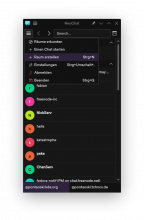A few of our desktop apps have been moving to a hamburger menu for presenting UI, and a few of our mobile apps utilise a hamburger menu of some form.
While doing some research on the topic of hamburger menus, I noticed anything involving actual user testing unanimously (I could not find any sources with actual research on users that indicated that hamburger menus performed better than other UI elements that could be used instead of them) pointed out that hamburger menus provide worse usability in all sorts of scenarios: users perceived the UI as harder to use, users interacted with hamburger menus less, users took longer to accomplish tasks, among other shortcomings of hamburger menus compared to other UI elements.
The sources I found: (feel free to edit sources [with actual research/testing, not pure conjecture/opinion as many UX/UI articles on the internet tend to be] into this list)
- https://www.nngroup.com/articles/hamburger-menus/
- https://web.archive.org/web/20150315043320/http://exisweb.net/mobile-menu-abtest
- https://web.archive.org/web/20150314233342/http://exisweb.net/menu-eats-hamburger
- https://www.diva-portal.org/smash/get/diva2:922114/FULLTEXT01.pdf&lang=en
With that in mind, I would like to propose that we reduce the already-low reliance of our UIs on hambuger menus. This is already not a very prevalent UI component in KDE, and we should work to remove it from the few apps that do use it.
Most of our apps using hamburger menus are surprisingly desktop apps, and not mobile apps. However, some of our mobile apps still use them.
Hamburger menus on mobile aren't an inevitability due to limited screen space as they would seem at first, and a few mobile platforms, most notably iOS, avoid the hamburger menu completely. In fact, Apple has explicitly denounced hamburger menus on iOS multiple times. A fun roast to read from Apple WWDC 2014 on hamburger menus: https://invent.kde.org/-/snippets/1747
I would like to use this thread to
- solidify our mobile design patterns so that we don't have developers & UI designers using hamburger menus because they don't know what else to do
- brainstorm ideas for apps that have hamburger menus to port them away from hamburger menus







